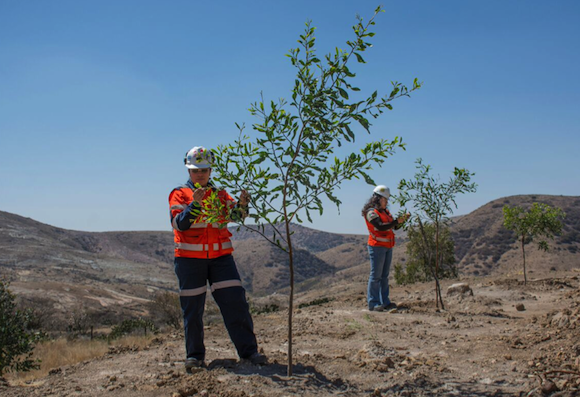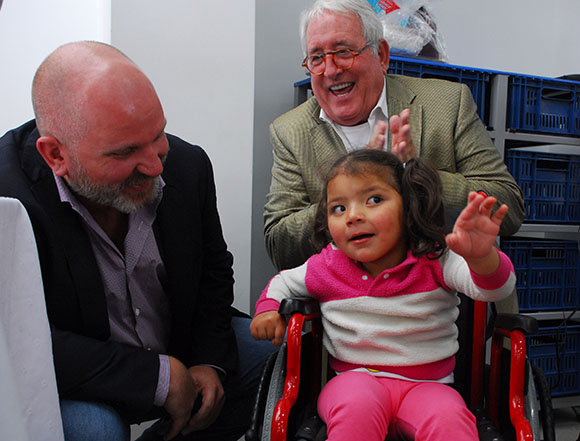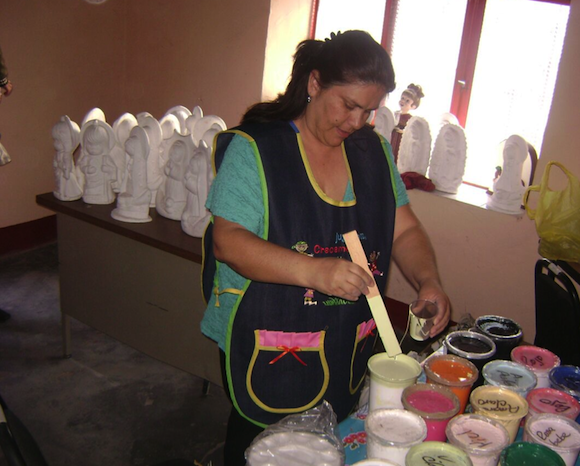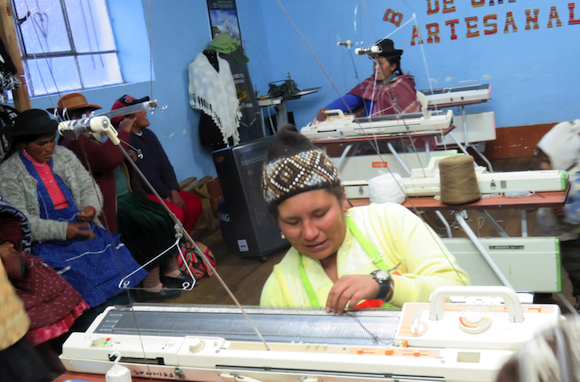Why CSR Makes Sense For Communities, Companies And Investors
TM editors' note: This article discusses a penny stock and/or microcap. Such stocks are easily manipulated; do your own careful due diligence.
Mining companies and their shareholders have come to the realization that doing the right things in the communities where they operate is important for a lot of reasons, including the bottom line. Mining executives also tell The Gold Report that the most effective corporate social responsibility programs (CSR) are orchestrated cooperatively instead of applied prescriptively.

In 2014 Endeavour Silver planted more than 40,000 trees as part of its commitment to reclaiming and restoring land disturbed during the mining process. Photo courtesy of Endeavour Silver.
The emphasis of mitigating the economic, social and environmental impacts of mining on local communities can be seen in the billion-dollar price tags on education and clean water projects in Ghana underwritten by Rio Tinto Plc (RIO:NYSE; RIO:ASX; RIO:LSE; RTPPF:OTCPK), training programs in Burkina Faso co-financed by IAMGOLD Corp. (IMG:TSX; IAG:NYSE) and small business loan programs in Peru funded by Barrick Gold Corp. (ABX:TSX; ABX:NYSE). As the Mining Association of Canada puts it on its website, corporate social responsibility (CSR) standards "are one way that companies can help manage risks and avoid potential conflicts. . .as an industry we also support community development to help spur local business development, build environmental expertise and reduce poverty in the areas where we operate."
Companies large and small have found that an investment in the people living where they work can have outsized returns in human impact terms, permitting time and even the ability to continue operating. But they have also learned that programs have to be designed in cooperation with local communities rather than imposed on them to have a lasting impact.
A Social License
Great Panther Silver Ltd. (GPR:TSX; GPL:NYSE.MKT) has taken a measured approach to its good neighbor policy. "Our main priority," according to Mariana Fregonese, director of Corporate Communications and Sustainability, "is to listen to what our stakeholders have to say. This isn't about telling them what they need and then doing it for them. We need to get to know each other and build trust in each community where we operate because their needs and realities are different. Afterwards, we work in a partnership approach to achieve shared goals."
At the San Ignacio mine, a half-hour from the main Guanajuato mine facility in town, the needs are much different. "We met with our neighbors when we started developing this new mine and quickly learned that the community had an active environmental problem because they were importing bottled water and burning the plastic containers, thereby releasing toxins in the air. We developed an easy training program to separate different types of plastics and set up recyclers to come every two months, with the profits from selling the materials matched by the company and used for community events," Fregonese said. By the end of the year, she anticipates that 1.5 tonnes of plastic will have been recycled in a community of only 500 people.
One woman approached Fregonese after the company opened a community center closer to its Guanajuato mine and processing plant, and explained how having that place to go and connect with other women of the community had changed her life and helped her recover from a difficult situation. "She is now employed full time and helping other women in similar situations in our community center. That is an example of a true partnership having a real impact. It is highly rewarding."
CSR has become part of doing business for Great Panther. When the company acquired Cangold Ltd. and its option on the Guadalupe de los Reyes exploration project in the Sierra Madre range in Sinaloa, Mexico, in May, a social assessment was launched the same time as the environmental study. In this case, it came back that the handling of drinking water was a challenge. "We held a hands-on clinic to work with local women to address health issues associated with hygiene, water sanitation and food handling," explained Fregonese. "With 90 local women participating in these workshops, we anticipate that approximately 80% of the local population benefited from this program."
"It doesn't cost a lot of money, but it shows we understand and care. Throwing money around is not always the answer; it is normally counterproductive," said Bob Archer, Great Panther Silver CEO and president.
It seems to be working. When a landowner built a fence and tried to block the drills from getting to the project site, the community came out in support and convinced him to let them by. "That is an example of how building a social license can make a huge difference," Archer said.
Fregonese is involved in the Prospectors & Developers Association of Canada (PDAC) and the Association for Mineral Exploration in British Columbia (AME BC) CSR committees and finds it important to share best practices among CSR practitioners and to adopt international environmental and social standards. "We, as an industry, can generate economic development and bring better sustainable lives to the local communities."
"The word sustainability gets kicked around a lot," said Archer. "But it is key to moving forward in this environment. Shareholders need to know which companies are taking a sustainable approach and are properly managing their social risks. You can have all the money you want, but when it comes to community support, a CSR can trump money in the bank."
A Cooperative Approach
Thyana Alvarez Claro, director of Responsabilidad Social at Red Eagle Mining Corp. (RD:TSX.V) (RDEMF), which has a mine under construction at the Santa Rosa gold project near the city of Medellin in Colombia, said being a good neighbor is particularly important in that part of the world. "Mining has typically been small scale and brought negative impacts, including drug addiction and illegal activity," she said. "We are showing the community that a gold mine can bring positive impacts including education, cultural events, sports opportunities and sustainable jobs."
Red Eagle takes a cooperative approach to community involvement. "We work together with the community, government leaders, the local church and stakeholders. It is not paternal. They decide the priorities and education is one of the biggest ones. That is why we started an adult computer literacy program that has already worked with 375 people to give them the tools to be productive. Another 100 have already enrolled in the adult elementary and secondary program. This is important in the villages where many only have fifth grade educations."
Red Eagle Mining also recently participated in a program with the Lookout Ridge Foundation to donate 70 wheelchairs to local residents, including children like three-year-old Laura Arboleda, previously limited by lack of mobility. Streetwise Reports founder Gordon Holmes' Lookout Ridge Foundation, which has both a Canadian and a U.S. nonprofit, works with individuals, mining companies, other companies and The Wheelchair Foundation, which has donated more than one million wheelchairs in more than 100 countries. "A principle of Red Eagle since its foundation has been returning benefit to the communities where we work," said CEO Ian Slater during his speech at the presentation ceremony.

Laura Arboleda receives a wheelchair from Red Eagle CEO Ian Slater (left) and Gordon Holmes (right).
The company focuses on being part of the community by hiring locally as well. Of the 175 people employed at the site so far, 75% are from the local area, which is made up of about 1,000 families on the outskirts of a larger city of 45,000 people.
While calculating the return on investment of CSR can be difficult to pin down because often it requires guestimating things that didn't happen, including lawsuits and an expanded permitting process, Alvarez Claro was able to point to some real results. "The reception has been enthusiastic and that good work is part of the reason Red Eagle mining was able to get the licenses it has obtained," she said. "Of some 60 mining companies that had been exploring in Colombia in the last decade, fewer than seven are left and only Red Eagle has been permitted to start a mine."

Endeavour's entrepreneurship programs include providing mining skills training to women, the young and unemployed, and providing the training and equipment to support local businesses. Photo courtesy of Endeavour Silver.
At Bolanitos, one of the first steps when the company arrived was to reinforce the tailings dam to North American standards, install a water recovery system to recycle most of the used water from the plant back to the plant, and create a tunnel system to segregate natural creek and rain water from the tailings water. Endeavour's entrepreneurship programs at Bolanitos include providing mining skills training to women, the young and unemployed, and providing the training and equipment to support pastry and jewelry-making businesses.
At El Cubo, the company inherited a unionized work force. "They were accustomed to confrontation not cooperation, so we focused on rebuilding that relationship with our own employees from scratch," Cooke explained. "We really needed them on board with our approach to business because we quickly launched a major $67 million rebuild of the mine, plant and surface facilities. I am pleased to say they slowly but surely bought in to our more sustainable approach and we were able to deliver our major rebuild on time and budget." The company is also working with the Economic Development Department in Guanajuato to provide skill-based training and a virtual university to provide high school educations for kids in the local communities.
In 2014, Endeavour invested $515,000 on sustainability programs in Mexico, not including staff time. In recent years, Endeavour has become one of only a few Canadian mining companies to report sustainability goals and accomplishments under the most rigorous level 4 of the GRI reporting framework.
"It is not only the right thing to do, embracing sustainability as a core value of the company is one of the main reasons we have been so successful in Mexico," Cooke said. "The people living in these rural communities in Mexico have forebears who have been there for centuries, so we took the view that Endeavour needed to become proactive local citizens and good neighbors. We can't do everything, but by partnering with each local community to identify and address their key issues and opportunities, we can do the things we say we will do, build trust and make a positive difference in people's lives."
Good Stewards
Barbara Henderson, director of investor relations at Bear Creek Mining Corp. (BCM:TSX.V) (BCEKF), also stresses the importance of being a partner rather than an ATM machine. "This is not a hand out approach, but a hand up," she said.
The company's Corani project is located in a sparsely populated high desert environment in southern Peru where the primary occupation of the local community members is alpaca farming. That is why the CSR focus has been on education, agriculture, health and nutrition, and water improvement. An example of a unique partnership that built on community strengths was an initiative to help local farmers and artisans maximize the price they were getting for their very high-quality alpaca wool. Bear Creek helped bring in equipment to certify the fibre fineness, provided educational opportunities on spinning fine gauge wool, provided short-term loans for mechanized knitting and weaving equipment, and arranged meetings with wool brokers to assist in direct sales to end users. As an additional value-add, local garment-makers have developed a niche alpaca-wool "smart-garment" clothing line, producing sweaters with e-fibres woven in to monitor stress levels and link to smartphones. Maki Silver sweaters and socks woven with naturally antibacterial silver threads are beneficial to diabetics and others with compromised health.
Alpaca in Peru. Bear Creek Mining partners with the community to promote alpaca businesses. Photo courtesy of Bear Creek Mining.
"Now local farmers are able to sell their wool directly to end users in Lima, receiving four to five times their historic revenue, and artisans are able to direct-sell their garments to purchasers," Henderson said. "The communities at large have benefitted as a result of improving income, which in turn has raised health and education levels. It is by all measures an enormous success and a perfect example of corporate-assisted community empowerment."

Bear Creek Mining provides assistance to local community businesses. Photo courtesy of Bear Creek Mining.
Henderson summed up, "To Bear Creek, helping local communities is first and foremost a moral and ethical imperative, but the good will also flows to investors because having respectful relationships with communities can help smooth the path to production and shrink the permitting timeline by building trust. By demonstrating that we are good to our word in this context, community members can trust us when it comes to being good stewards as we develop and operate the Corani project."
Disclosure: 1) JT Long conducted this interview for Streetwise Reports LLC, publisher of The Gold Report, The ...
more


